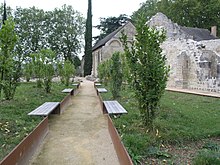St. Cosmas Priory
The fallen priory of St. Cosmas (French: Prieuré de Saint-Cosme , also Priorei des Ronsard ) on an island in the Loire River near La Riche near Tours in Touraine was founded in the 11th century and is dedicated to St. Cosmas. The complex contains a museum for the French poet Pierre de Ronsard , who lived here for the last 20 years according to the monastery rules that apply here. There is also a collection of modern poetic works here.
history
In 1092 an Augustinian community founded the priory in place of an oratory from the 7th century as a resting place for pilgrims on the Way of St. James to Santiago de Compostela in Spain. The priory served this purpose until the 18th century.
In 1187, Henry II of England (to whom the monastery was then subordinate) granted the exiled Archbishop of Trier Folmar von Karden refuge in the monastery. At that time, the priory was considered "paradise on earth, easier to reach than real paradise".
In the 15th century the priory benefited from the favor of King Louis XI. who at that time sometimes stayed in the neighboring castle of Plessis-lès-Tours . He had the church and the prior's house rebuilt in Gothic style.
From 1565 to 1585, Pierre de Ronsard was prior of the community. He lived in the prior's house, now a museum dedicated to him, and received visits from Catherine de Medici and her son, King Charles IX. of France, from the future King Henry III. from France and others. He died on December 27, 1585 at the age of 61 and was buried in the church choir . His grave was found in the 1930s.
In 1742 the monastery was dissolved and partially demolished.
The property was bombed and partially destroyed during World War II. The prior's house, the ruins of the church and the refectory have been preserved .
Memorial and museum
In 1951, the Indre-et-Loire district undertook a comprehensive excavation of the area and made the site accessible to the public.
Starting in 1988, nine gardens were laid out, which have been designated as Jardin remarquable . After extensive excavations between 2009 and 2010, the gardens underwent another renovation in 2015. Using uniform materials (robinia and chestnut wood, oxidized metal and ceramics), a coherent overall concept was implemented. Twelve themed gardens with corresponding borders reveal the dimensions of the former buildings. 75 different types of fruit were planted. The human remains from 420 graves found a new place in the roof of the church.
collection
The literary museum in the prior's house contains an extensive collection of livre pauvre . These are poetic works that are artistically illustrated and, when folded, are reminiscent of books in the broadest sense. The design is done with simple means, with painting, collage or calligraphy . The collection goes back to the literature professor Daniel Leuwers , who laid the foundation stone for this collection in 2002.
In 2011, the Chinese painter Zao Wou-Ki from the Indre-et-Loire district was invited to decorate 14 windows of the refectory with stained glass.
Web links
Individual evidence
- ^ Prieuré St Cosme. Retrieved June 29, 2017 (fr-fr).
Coordinates: 47 ° 22 ′ 56.6 " N , 0 ° 40 ′ 42.6" E




